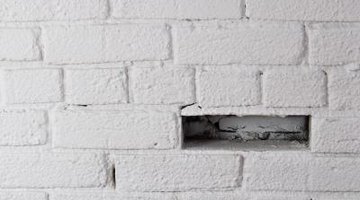How to Take White Paint Off Red Brick
Red brick is a classic look for a home's exterior, front walkway or fireplace surround, and exposed brick is often an architectural selling point of historic lofts or homes.

Some homeowners opt to paint over brick detailing in an effort to bring an older home into the more modern age, and white if often the go-to color for remodelers looking for a more neutral color palette. The best method for removing white paint from your brick detailing depends on the extend of the paint to be removed.
Things You Will Need
- Protective gloves
- Eye goggles
- Face mask
- Gel or paste paint removers
- Scrap fabric strips
- Warm water
- Stiff brush
- Heat gun
- Semi-firm scraper
Warning
Brick is often painted to hide defects in the original brick, so be prepared to restore your bricks after you remove the paint.
Chemical strippers should only be used on new brick as historic brick is fragile and chemical strippers damage the porous surface of the brick.
Painted Surfaces
-
Ventilate your working area. Gel and paste paint removers are less toxic than chemical paint strippers, but ventilation ensures your respiratory safety. Open nearby windows, or use a box fan to draw fumes outside.
-
Put on your protective gloves and goggles to protect your skin and eyes while handling the paint remover.
-
Mix the gel or paste paint remover according to the manufacturer's instructions. Some brands require that your add water or mix two compounds together to create the removing agent.
-
Apply a thin layer of the gel or paste paint remover to your painted brick. Use a wide putty knife so that you can control the thickness of the paste and cover large areas at one time.
-
Cover the paste with strips of scrap fabric before the paste dries. Press the fabric onto the gel or paste.
-
Allow the paste to soak into the paint on your brick surface for as long as the manufacturer recommends, typically at least 10 minutes.
-
Peel the strips of fabric gently off of the surface of the brick. The gel or paste paint remover will have softened the paint as well as adhered to the fabric so that the paint will come off as you peel. Discard the fabric strips.
-
Wash excess paste or gel from your brick with a rag and warm water. Use a stiff bristle brush to remove any remaining paint or gel.
Paint Splatters or Small Areas
-
Ventilate your work space. Heating up lead-based paint will release fumes into the air, so proper ventilation is essential for your safety. Wear a face mask, goggles and gloves.
-
Warm up your heat gun per the manufacturer instructions. Most guns require a power outlet and a brief warm up period of five to 10 minutes.
-
Hold your heat gun over the white paint splatter on your brick. The length of time you'll need to hold the gun over the paint varies based on the type and thickness of the layer of paint. Hold the gun in place until the paint begins to bubble and appears to be melting.
-
Use your free, gloved hand to scrape away the paint with your semi-firm scraper.
-
Move the gun to the next paint spot and repeat the process until all the paint is removed. If needed, wash the brick with warm water and a stiff bristle brush to remove remaining paint.
The Drip Cap
- Red brick is a classic look for a home's exterior, front walkway or fireplace surround, and exposed brick is often an architectural selling point of historic lofts or homes.
- Some homeowners opt to paint over brick detailing in an effort to bring an older home into the more modern age, and white if often the go-to color for remodelers looking for a more neutral color palette.
- Put on your protective gloves and goggles to protect your skin and eyes while handling the paint remover.
- Mix the gel or paste paint remover according to the manufacturer's instructions.
- The gel or paste paint remover will have softened the paint as well as adhered to the fabric so that the paint will come off as you peel.
- Ventilate your work space.
- Wear a face mask, goggles and gloves.
References
Writer Bio
Hannah Wahlig began writing and editing professionally in 2001. Her experience includes copy for newspapers, journals and magazines, as well as book editing. She is also a certified lactation counselor. She holds a Bachelor of Arts in English from Mount Holyoke College, and Master's degrees in education and community psychology from the University of Massachusetts.
Photo Credits
- Jupiterimages/Photos.com/Getty Images
- Jupiterimages/Photos.com/Getty Images
More Articles



